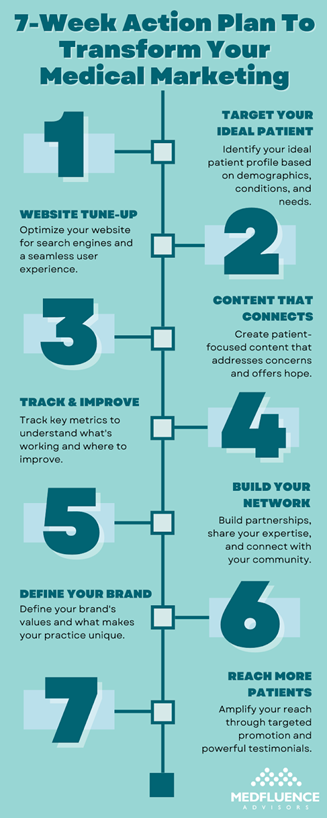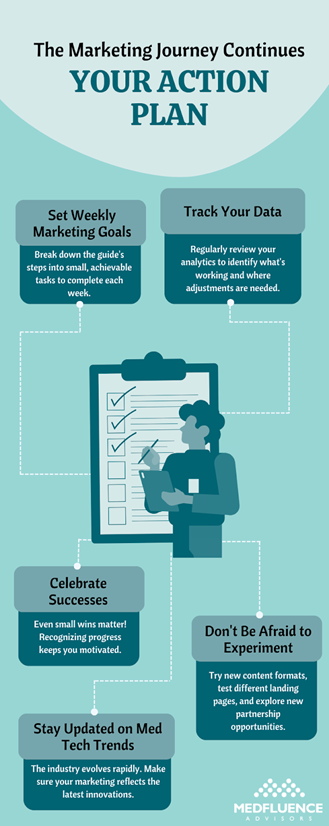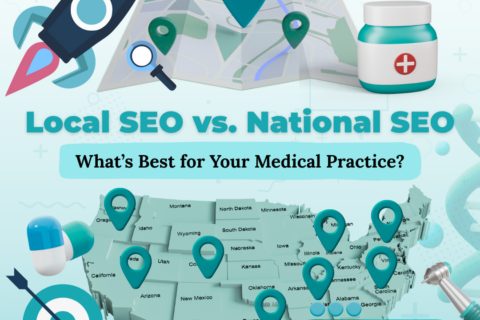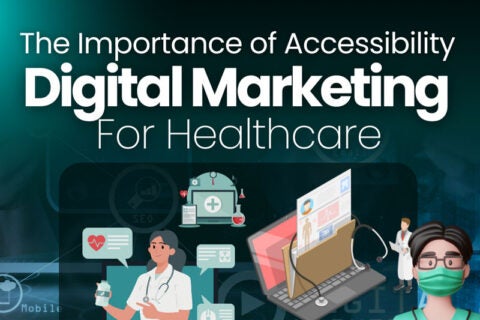7-Week Action Plan to Transform Your Medical Marketing
In today’s competitive healthcare landscape, both private medical practices and those at the forefront of medical tech innovation face a constant uphill battle. Between the pressure from big hospital systems, the ever-rising costs of reaching the right audience, and patients demanding a more personalized experience, it can feel like you’re shouting into the void.
You know you provide excellent care or groundbreaking technology, but how do you break through the noise and connect with those who truly need what you offer? Maybe you’re stuck with outdated marketing tactics that just don’t seem to work, or you simply lack the time or specialized know-how to navigate the ever-changing digital landscape.
All this leads to frustration, wasted budgets, and the disheartening feeling of missing out on connecting with those who truly need your care or innovations. But this guide isn’t about theoretical concepts; it’s a hands-on roadmap designed to transform your medical practice marketing. We are going to provide you with step-by-step instructions, real-world examples, and practical tools to help you:
- Identify your ideal patients and the procedures that will make the most significant impact on their lives.
- Optimize your website to attract, educate, and convert more prospective patients.
- Develop compelling content that speaks to the hearts and minds of your target audience.
- Increase your visibility online and build trust within your community.
If you’re ready to stop wasting time and money on ineffective marketing tactics, this guide is for you. Let’s get started!

Week 1: Identifying Ideal Patients and Procedures
Building a thriving practice isn’t merely about casting a wide net, it’s about targeting the right patients – those who will truly benefit from the unique expertise and care you provide. Here’s what you need to do during the first week:
Understanding Your Target Patient
Let’s get specific. Forget generalized marketing lingo and focus on these key points:
- Demographics: Age range, location, income level, insurance types – the clearer your picture, the more targeted your marketing efforts can be.
- Health Conditions: What diagnoses do you see most frequently? What are the conditions you have the most success in treating?
- Motivations & Pain Points: What keeps a patient up at night? Are they frustrated with long wait times in other practices? Seeking a highly personalized treatment approach? Understanding their needs is essential for creating messaging that resonates.
Procedure Match
Now, let’s align your expertise with your ideal patient:
- Which procedures consistently deliver the best outcomes for your patients? Consider success rates, patient satisfaction, and the impact on quality of life.
- Which patient profiles (based on the above criteria) are the best candidates for each of your top procedures?
Keyword Brainstorming
It’s time to translate these insights into keywords people actually search for. Here’s how:
- Think Like Your Patient: What words would they use to describe their condition, symptoms, or desired outcomes? (e.g., “chronic back pain relief,” “minimally invasive knee surgery”)
- Location Matters: Include your city, region, or neighborhood in your keywords to attract local patients. (e.g., “Shoulder pain specialist in [your city]”)
- Google Keyword Planner: This free tool can expand upon your initial ideas, providing search volume data to help you gauge the popularity of different terms.
According to recent data, over 83% of internet users turn to search engines for health information, and nearly 7% of all daily Google searches are health-related. This tells us that your potential patients are actively searching online for solutions.
Week 2: Optimizing Your Website’s Health
Think of your website as your practice’s digital storefront. It needs to be in tip-top shape to attract and convert potential patients. This week, we’ll conduct a technical SEO audit, prioritize fixes, and ensure your site effectively showcases your expertise.
Technical SEO Audit
Even the most beautifully designed website can be held back by hidden technical issues that make it harder for search engines to understand and rank your content. Here’s what to look for:
- Tools: Ubersuggest and SEMRush offer comprehensive site audit tools.
- Critical Errors: Focus on issues like broken links, slow page load speed, missing title tags and meta descriptions, and mobile responsiveness. These can significantly impact user experience and search rankings.
- Less Urgent Issues: Tackle things like image optimization, duplicate content, and keyword density once the major errors are fixed.
Prioritizing Fixes
Addressing critical errors should be your number one priority. Many of these can be fixed quickly and have an immediate impact on your site’s visibility. Here’s why urgent fixes are so important:
- User Experience: If your site loads slowly or has broken links, visitors may leave quickly, leading to high bounce rates. This is a major red flag for search engines – they interpret it as a sign of a poor-quality website. Especially in today’s fast-paced online world, patience is thin! Over half of visitors will ditch a slow-loading page within 3 seconds, and most people expect sites to appear almost instantly (within 2 seconds). Make sure your website prioritizes speed to keep visitors engaged and happy.
- Crawlability: Search engine bots need to be able to easily navigate your site. Technical errors can create roadblocks, making it difficult for important pages to be indexed.
Highlighting Your Expertise
Don’t let your website be a mere online brochure. Use it to establish yourself as an authority:
- Display relevant certifications, training, and affiliations your doctors hold.
- Do you specialize in cutting-edge techniques or minimally invasive procedures? Highlight them!
- Include sections dedicated to answering common patient questions, explaining procedures, and showcasing success stories (with permission).
Your website is a powerful tool to build trust and credibility with potential patients even before they set foot in your practice.
Week 3: Crafting Compelling Patient-Focused Content
Your third week is all about creating content that connects with your ideal patients on an emotional level while also providing valuable information. Think of this as going beyond marketing – it’s about sharing the heart of your practice.
Patient Stories
Nothing demonstrates the impact of your work more powerfully than real-life success stories. Here’s how to make them resonate:
- The Power of Transformation: With the patient’s permission, focus on how their life has changed after treatment. Frame it as a journey, highlighting the challenges they faced before and the positive outcomes experienced.
- Anonymity is Key: Respect patient privacy. Use first names only or create composite stories inspired by multiple patients.
- Diverse Voices: Showcase a range of patient experiences to resonate with different segments of your ideal audience.
Addressing Patient Concerns
Build trust by proactively answering the questions and worries potential patients have.
- Common Fears: Anticipate anxieties about treatment, pain management, recovery, costs, etc. Directly address these with compassionate, reassuring information.
- Question & Answer Format: Blog posts or short explainer videos work well for this. Use keywords patients might search for (e.g., “minimally invasive surgery recovery time”)
- Showcase Your Expertise: Weave in your knowledge, success rates, and the unique approaches your practice takes to put patients at ease.
Empathetic and Informative Tone
Medical information can be intimidating. Your content should strive for these qualities:
- Avoid Jargon: Explain complex medical concepts in plain language. Use analogies and examples to make information easily digestible.
- Conversational Style: Imagine you’re speaking directly to a patient. Be approachable and reassuring, like a trusted advisor.
- Accuracy Matters: Partner with your physicians to ensure all content is medically sound. Cite credible sources if necessary.
Great content is not only informative, it inspires hope. This is your chance to show patients that you understand their struggles and are committed to helping them achieve better health.
Week 4: Tracking Results and Making Adjustments
Marketing isn’t a “set it and forget it” endeavor. To make the most of your efforts, you need to understand what’s working, what’s not, and where to optimize. This week, we’ll turn insights into action!

Let’s talk about the power duo of website analytics:
- Google Analytics: This free and powerful platform is your go-to for tracking website traffic, user behavior (how long they stay on your site, pages visited), traffic sources (where visitors come from), and conversions. Make sure to set up goals in Analytics to track things like inquiries, appointments booked, and other important actions.
- Google Search Console: This complements Google Analytics by showing you how your site performs in search results. It reveals valuable data, including the keywords you rank for, click-through rates, and any technical errors detected by Google.
Identifying Success Patterns
Don’t just look at data, analyze it to find actionable insights! Ask yourself:
- Which pages on your website get the most traffic and keep visitors engaged? What makes them successful, and can you replicate those elements on other pages?
- Which search terms lead people to your site? Use this to refine your content and ensure you’re targeting the right keywords.
- Are most visitors coming directly, from search engines, or from referral sites? This tells you where to focus your outreach and promotion efforts to get the biggest bang for your buck.
- Which landing pages are most effective at turning visitors into patients? Focus on strengthening those and identify what makes those pages work so well.
Refining Your Strategy
Data-driven marketing is about continuous improvement. Here’s how to adjust your course:
- Double Down on Success: If a certain type of content or traffic channel is performing well, invest more resources in that area.
- Tweak and Test: If a page has high traffic but low conversions, experiment with different calls to action, design changes, or even rewrite the content.
- A/B Testing: Want to directly compare the performance of two variants of a landing page or email? Tools like Google Optimize make this easy.
Don’t get overwhelmed by the data. Start with a few key metrics you want to improve (e.g., website traffic from organic search, and appointment requests). Focus on those, and then expand your analysis over time.
Week 5: Building Connections and Authority
Growing your practice isn’t just about direct patient outreach. Strategic partnerships and increasing your visibility as an expert can unlock powerful growth opportunities. This week, focus on extending your reach beyond your existing patient base and establishing yourself as a trusted healthcare resource within your community by doing these:
Identify Relevant Partnerships
Start by brainstorming 5-10 businesses or organizations that serve a similar audience to yours, but aren’t direct competitors. The key is to look for opportunities for “value exchange.” Consider:
- Co-hosted webinars or educational events
- Cross-promotion on social media or via email newsletters
- Exclusive discounts for each other’s patients
Seek Out Guest Blogging Opportunities
Research 3-5 websites, blogs, or online publications that cover topics relevant to your ideal patients. Look specifically for sites that accept guest contributions. Don’t send a generic email! Instead, craft a short pitch showcasing a few article topics that would provide value to their readership and highlight your expertise. Focus on high-quality, niche-specific publications before aiming for the major health media outlets.
Get Involved in Your Community
Research local health-related organizations like patient support groups, charities, or community centers. Find out about upcoming events or ways you can volunteer your expertise. Consider sponsoring a local health fair, offering a free educational talk at a library, or building awareness for a health-related cause you support. Choose activities that align with your practice’s values and where you can make a meaningful contribution.
Building connections takes time and consistency. Set aside dedicated time each week to continue nurturing these strategies.
Week 6: Developing a Memorable Brand
Your brand is about more than just visuals—it’s about the feeling patients have when they interact with your practice. For Week 6, we’ll define your brand’s essence and ensure consistent messaging that resonates with your ideal patients.
Define Your Core Values
Think deeply about the kind of experience you want to create for every patient. What words come to mind – compassionate? Empowering? Innovative? List 3-5 words that describe this ideal experience; these become your core values.
Additionally, get input from your staff. They interact with patients daily; what do they believe sets your practice apart? Their insights can help you uncover unique aspects of your brand that you might not even have considered.
Craft Your Value Proposition
Focus on the “why.” Why should a patient choose you over any other practice? Zero in on your unique specialization, advanced technology, patient-centered philosophy, or whatever else sets you apart. Distill this into a short, memorable statement that you can easily integrate into your website, marketing materials, and even everyday conversations staff have with potential patients.
Here’s an example: “Restoring your health, empowering your future. We offer advanced, minimally invasive treatments with a personalized, compassionate approach.”
Ensure Consistency
Create a simple brand guidelines document that outlines your logo usage, color palette, fonts, and the overall tone of voice you’ll use across all communications. Review your existing materials – your website, social media, brochures, etc. Do they align with your newly defined brand? Update anything that’s out of sync.
Lastly, share your brand values and guidelines with your team. Consistency starts from within, and your staff is the front line of your brand experience! A strong brand builds immediate trust and recognition. Taking the time to define your brand now will have long-term payoffs.
Week 7: Amplifying Your Reach
You’ve put in the work to create valuable content and establish your brand. Now, it’s time to expand your reach and connect with even more of your ideal patients. For the final week, we will now focus on targeted promotion, leveraging social proof, and the importance of continuous improvement in your marketing efforts.

Targeted Content Promotion
Paid social media advertising platforms (like Facebook and Instagram) offer powerful targeting tools. Use these to boost your best-performing content or run ads tailored to specific audience segments based on demographics, location, and interests. Even a small budget can significantly increase the visibility of your practice.
Patient Testimonials and Reviews
Positive reviews and testimonials are incredibly influential! Encourage satisfied patients to leave reviews on platforms like Google, Yelp, or health-specific review sites relevant to your practice. Showcase these testimonials prominently on your website and social media channels.
Ongoing Refinement
Marketing is never truly finished. Continue analyzing data from your website analytics, social media insights, and patient feedback:
- Identify what resonates best with your audience
- Test new strategies
- Be willing to adjust course to achieve optimal results over time
Consistent effort is key. Building a successful practice takes time and dedication to both excellent patient care and effective marketing strategies.

The Marketing Journey Continues: Your Action Plan
Transforming your marketing can be a powerful growth accelerator, whether you’re a medical practice or involved in the emerging med-tech space. But, by following the steps outlined in this guide, you’ve laid a strong foundation. The key now is consistency and a willingness to adapt as you go.
Your Action Checklist
- Set Weekly Marketing Goals: Break down the guide’s steps into small, achievable tasks to complete each week.
- Track Your Data: Regularly review your analytics to identify what’s working and where adjustments are needed.
- Celebrate Successes: Even small wins matter! Recognizing progress keeps you motivated.
- Don’t Be Afraid to Experiment: Try new content formats, test different landing pages, and explore new partnership opportunities.
- Stay Updated on Med Tech Trends: The industry evolves rapidly. Make sure your marketing reflects the latest innovations.
Marketing is an ongoing investment in the growth of your practice or med tech venture. By consistently providing valuable information, building trust with your target audience, and showcasing your cutting-edge solutions, you’ll attract interest, gain visibility, and achieve your long-term goals.
Need further support? If you’d like personalized assistance with your marketing strategy, don’t hesitate to reach out.



